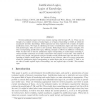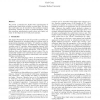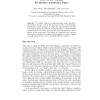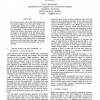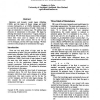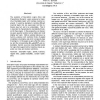AMAI
2008
Springer
14 years 3 months ago
2008
Springer
Several justification logics have been created, starting with the logic LP, [1]. These can be thought of as explicit versions of modal logics, or of logics of knowledge or belief,...
BIRTHDAY
2010
Springer
14 years 3 months ago
2010
Springer
Prominent logics, including quantified multimodal logics, can be elegantly embedded in simple type theory (classical higher-order logic). Furthermore, off-the-shelf reasoning syste...
ICFP
2010
ACM
14 years 4 months ago
2010
ACM
We present a technique for higher-order representation of substructural logics such as linear or modal logic. We show that such logics can be encoded in the (ordinary) Logical Fra...
CAEPIA
2009
Springer
14 years 4 months ago
2009
Springer
We slightly improve on characterization results already in the literature for base revision. We show that in order to axiomatically characterize revision operators in a logic the o...
ATAL
2010
Springer
14 years 4 months ago
2010
Springer
We present the logic CTL.STIT, which is the join of the logic CTL with a multi-agent strategic stit-logic variant. CTL.STIT subsumes ATL, and adds expressivity to it that we claim...
ATAL
2010
Springer
14 years 4 months ago
2010
Springer
Many problems in AI and multi-agent systems research are most naturally formulated in terms of the abilities of a coalition of agents. There exist several excellent logical tools ...
IJCAI
1993
14 years 4 months ago
1993
We introduce and use a new methodology for the study of logics for action and change. The methodology allows one to define a taxonomy of reasoning problems, based in particular on...
FLAIRS
1998
14 years 4 months ago
1998
Epistemic and doxastic modal logics (Hintikka [1962]), and the logics of theory change and belief revision (Alchourr6net. al. [1985], Giirdenfors [1988]) are used for the represen...
IJCAI
2003
14 years 4 months ago
2003
The evolution of Description Logics (DLs) and Propositional Dynamic Logics produced a hierar chy of decidable logics with multiple maximal el ements. It would be desirable to ...
CLIMA
2010
14 years 4 months ago
2010
Simple type theory is suited as framework for combining classical and non-classical logics. This claim is based on the observation that various prominent logics, including (quantif...
